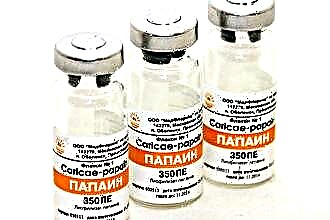Tonsils or tonsils are accumulations of lymphoid tissue in the oral cavity and nasopharynx, a kind of "shield" of the body against harmful bacteria and viruses, a hematopoietic and immunostimulating organ.
Tonsils are of two types - paired and unpaired. In turn, the paired ones are divided into palatal (the name determines the location - the sky) and trumpet (located next to the auditory tube). Unpaired - the lingual tonsil, located under the tongue, and the pharyngeal, which is located in the fornix and back of the pharynx.
Enlargement of the tonsils in children
 With frequent infection, the tonsils work "for wear and tear" and can "fail" if the immune system fails. The glands are enlarged and pose a risk to the health of the child. It is possible that otitis media may occur - inflammation of the Eustachian tube, as well as other complications (sinusitis, rhinitis).
With frequent infection, the tonsils work "for wear and tear" and can "fail" if the immune system fails. The glands are enlarged and pose a risk to the health of the child. It is possible that otitis media may occur - inflammation of the Eustachian tube, as well as other complications (sinusitis, rhinitis).
Staphylococci and streptococci are especially often harmful to the tonsils. Inflammation of the tonsils caused by these microorganisms leads to angina (acute tonsillitis) and requires immediate treatment due to weak defense mechanisms and insufficient maturity of these organs in children.
The resulting complications affect:
- on the cardiovascular system, when, for example, rheumatism and heart disease can lead to disability;
- on the musculoskeletal system (joint damage);
- on the genitourinary organs (kidney pathology, impaired fertility)
As noted, the ears and nasopharynx are at greatest risk.
The main symptoms
 Impaired swallowing reflex: Difficulty eating, drinking, and even swallowing saliva. They will facilitate the process of changes in the diet (spicy and solid foods must be excluded).
Impaired swallowing reflex: Difficulty eating, drinking, and even swallowing saliva. They will facilitate the process of changes in the diet (spicy and solid foods must be excluded).- Elevated temperature. It is noted that taking medications that "knock" her down does not give results - it is necessary to overcome the bacterial infection.
- Difficulty breathing due to enlargement and swelling of the tonsils. Medical treatment under the supervision of a physician is highly recommended.
- Inflamed lymph nodes. This is an indicator that the fight of the immune system and the body with viruses and bacteria is in full swing. Heating is strictly prohibited!
- Smell from the mouth. A large accumulation of microbes on the tonsils gives a bad smell. Rinsing and inhaling will correct the problem.
Generalized signs: weakness, depressed mood, sleep disturbance, headaches and dizziness, nausea.
Treatment of inflammation and enlargement of the tonsils in children
Before prescribing treatment, a diagnosis must be made. This is especially important when it comes to children in the first year of life. Angina can be fatal if the cause of the inflammation is not identified in time.
 The main thing in the treatment of angina is the correct antibiotic and its dosage. To avoid allergic reactions, doctors recommend drugs that are referred to as macrolides.
The main thing in the treatment of angina is the correct antibiotic and its dosage. To avoid allergic reactions, doctors recommend drugs that are referred to as macrolides.
Additional procedures and methods of dealing with the disease:
- Washing the tonsils is especially important for tonsillitis. Depending on the degree of inflammation, 5-10 procedures are prescribed. The rinse is based on water and potassium permanganate. Principle of action: the resulting pus, as well as all kinds of bacteria, are washed off with a solution. It should be noted that the effect is immediate, and the process itself is painless. At the same time, the child's “unpleasant” odor from the mouth disappears, purulent stagnation disappears and the state of health improves.
- Complete rest. The child should avoid physical activity, conserving their energy resources and strength.
- Balanced diet. You must follow a diet: give preference to chicken broth, cutlets or steamed meat.
- Taking vitamins is required not only during illness, but also as a means of prevention in order to strengthen the immune system.
Removal of tonsils for a child
When the above treatment methods do not help with inflamed glands, they resort to surgical intervention - tonsillectomy. This operation is not difficult, therefore it is carried out under local anesthesia, but the age characteristics of young patients - high physical activity - force them to resort to general anesthesia.
 One of the few conditions before removing tonsils is not to eat. The operation is divided into three stages:
One of the few conditions before removing tonsils is not to eat. The operation is divided into three stages:
- Preparatory. Anesthesia is administered. This is done with the help of a special mask, the child loses consciousness and he will not feel pain.
- Basic. The doctor removes the lymphoid tissue, leaving the healthy portion of the tonsils intact.
- Final. The patient wakes up.
There are different types of such an operation: surgical intervention with a scalpel, laser removal, method of freezing tonsils, ultrasound technique and electrical tonsillectomy.
The choice of a specific method directly depends on such factors: the age of the child, contraindications to a particular method, and the degree of inflammation.
Contraindications when children cannot undergo surgery:
- Problems with teeth and gums, oral cavity in general.
- Poor blood clotting.
- Kidney, liver, or heart disease.
- Infectious diseases.
Traditional methods
 Perfectly relieves inflammation of the tonsils in children, a decoction of a string, chamomile and pine buds. Each ingredient should be collected in one bowl, pour boiling water over, cover and leave for 10-15 minutes. After the liquid has cooled to room temperature, the child can begin gargling. The procedure must be repeated 3-5 times a day, the rinsing time is 3 minutes. Do not be limited to the above set of herbs, you can combine, for example, calendula, sage and violet.
Perfectly relieves inflammation of the tonsils in children, a decoction of a string, chamomile and pine buds. Each ingredient should be collected in one bowl, pour boiling water over, cover and leave for 10-15 minutes. After the liquid has cooled to room temperature, the child can begin gargling. The procedure must be repeated 3-5 times a day, the rinsing time is 3 minutes. Do not be limited to the above set of herbs, you can combine, for example, calendula, sage and violet.
For faster removal of inflammation, children can be inhaled.
The main options for solutions for inhalation:
- with iodine (a few drops) and baking soda ("sea water effect");
- with chlorhexidine;
- with eucalyptus, chamomile, oak bark;
- using boiled potatoes (unpeeled).
How to inhale children?
The prepared broth should be put on the table, remove the lid and wait a couple of minutes. Hot steam is dangerous for the baby's "tender" throat. You can cool it down a little. Then you should bend over the dishes with the healing broth so that it is convenient to inhale. For greater effect, the child's head should be covered with a towel. Inhalation is prohibited for purulent sore throat.

 Impaired swallowing reflex: Difficulty eating, drinking, and even swallowing saliva. They will facilitate the process of changes in the diet (spicy and solid foods must be excluded).
Impaired swallowing reflex: Difficulty eating, drinking, and even swallowing saliva. They will facilitate the process of changes in the diet (spicy and solid foods must be excluded).

